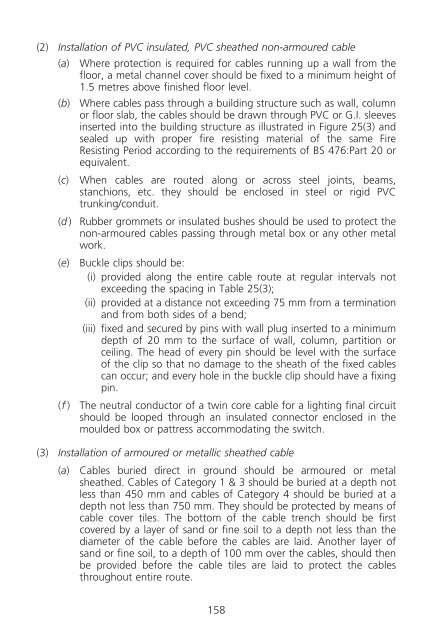Code of Practice for the Electricity (Wiring) Regulations - 2009 Edition
Code of Practice for the Electricity (Wiring) Regulations - 2009 Edition
Code of Practice for the Electricity (Wiring) Regulations - 2009 Edition
Create successful ePaper yourself
Turn your PDF publications into a flip-book with our unique Google optimized e-Paper software.
(2) Installation <strong>of</strong> PVC insulated, PVC shea<strong>the</strong>d non-armoured cable<br />
(a) Where protection is required <strong>for</strong> cables running up a wall from <strong>the</strong><br />
floor, a metal channel cover should be fixed to a minimum height <strong>of</strong><br />
1.5 metres above finished floor level.<br />
(b) Where cables pass through a building structure such as wall, column<br />
or floor slab, <strong>the</strong> cables should be drawn through PVC or G.I. sleeves<br />
inserted into <strong>the</strong> building structure as illustrated in Figure 25(3) and<br />
sealed up with proper fire resisting material <strong>of</strong> <strong>the</strong> same Fire<br />
Resisting Period according to <strong>the</strong> requirements <strong>of</strong> BS 476:Part 20 or<br />
equivalent.<br />
(c) When cables are routed along or across steel joints, beams,<br />
stanchions, etc. <strong>the</strong>y should be enclosed in steel or rigid PVC<br />
trunking/conduit.<br />
(d ) Rubber grommets or insulated bushes should be used to protect <strong>the</strong><br />
non-armoured cables passing through metal box or any o<strong>the</strong>r metal<br />
work.<br />
(e) Buckle clips should be:<br />
(i) provided along <strong>the</strong> entire cable route at regular intervals not<br />
exceeding <strong>the</strong> spacing in Table 25(3);<br />
(ii) provided at a distance not exceeding 75 mm from a termination<br />
and from both sides <strong>of</strong> a bend;<br />
(iii) fixed and secured by pins with wall plug inserted to a minimum<br />
depth <strong>of</strong> 20 mm to <strong>the</strong> surface <strong>of</strong> wall, column, partition or<br />
ceiling. The head <strong>of</strong> every pin should be level with <strong>the</strong> surface<br />
<strong>of</strong> <strong>the</strong> clip so that no damage to <strong>the</strong> sheath <strong>of</strong> <strong>the</strong> fixed cables<br />
can occur; and every hole in <strong>the</strong> buckle clip should have a fixing<br />
pin.<br />
(f ) The neutral conductor <strong>of</strong> a twin core cable <strong>for</strong> a lighting final circuit<br />
should be looped through an insulated connector enclosed in <strong>the</strong><br />
moulded box or pattress accommodating <strong>the</strong> switch.<br />
(3) Installation <strong>of</strong> armoured or metallic shea<strong>the</strong>d cable<br />
(a) Cables buried direct in ground should be armoured or metal<br />
shea<strong>the</strong>d. Cables <strong>of</strong> Category 1 & 3 should be buried at a depth not<br />
less than 450 mm and cables <strong>of</strong> Category 4 should be buried at a<br />
depth not less than 750 mm. They should be protected by means <strong>of</strong><br />
cable cover tiles. The bottom <strong>of</strong> <strong>the</strong> cable trench should be first<br />
covered by a layer <strong>of</strong> sand or fine soil to a depth not less than <strong>the</strong><br />
diameter <strong>of</strong> <strong>the</strong> cable be<strong>for</strong>e <strong>the</strong> cables are laid. Ano<strong>the</strong>r layer <strong>of</strong><br />
sand or fine soil, to a depth <strong>of</strong> 100 mm over <strong>the</strong> cables, should <strong>the</strong>n<br />
be provided be<strong>for</strong>e <strong>the</strong> cable tiles are laid to protect <strong>the</strong> cables<br />
throughout entire route.<br />
158














